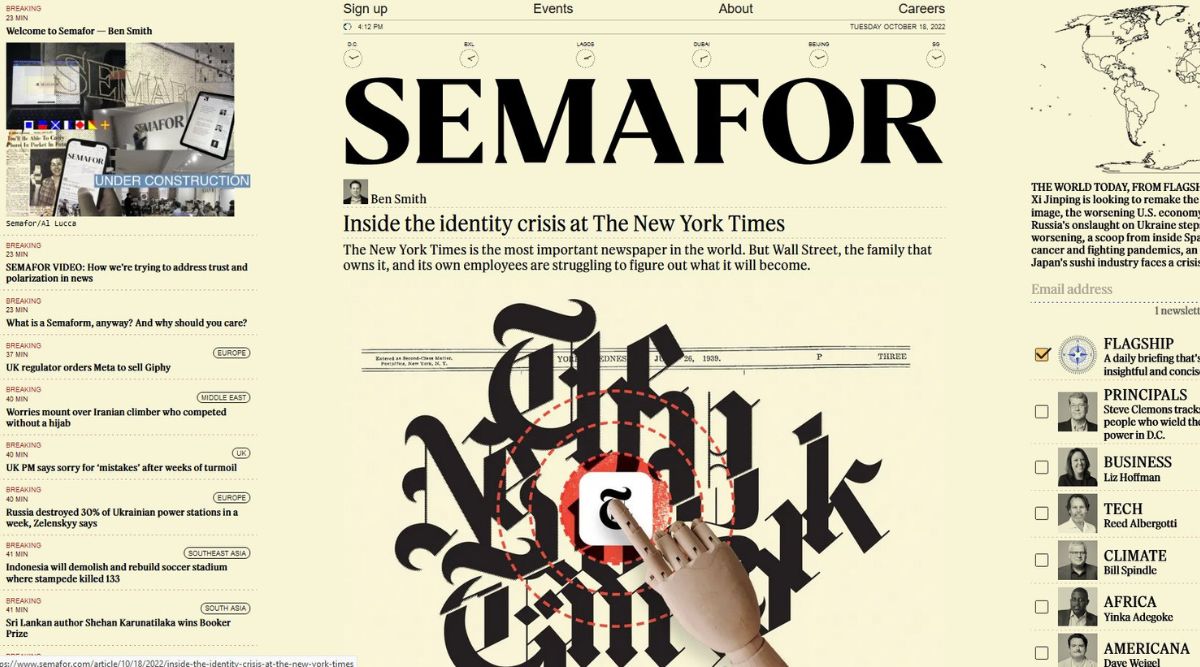Media organization Semafor launched on Tuesday with no less ambition than reinventing news history.
Semafor is the brainchild of Ben Smith — former New York Times media reporter and former BuzzFeed Editor-in-Chief — and Justin Smith, ex-CEO of Bloomberg Media. Since both men – who are not related – quit their previous jobs in January, Semafor has raised $25 million and hired more than 50 people.
Semafor’s website, with a distinctive yellow-tinged background that looks like a newspaper left out in the sun, went live Tuesday just after 6:00 am Eastern Time with eight newsletters and an events store.
“We see a great opportunity and are very excited to create a new and high quality independent global news brand obsessed with solving a number of major consumer frustrations we see in the news business, primarily polarization,” said Justin Smith, CEO of the new company.
The founders also believe that people suffer from information overload. While another media organization seems like an odd way to deal with this problem, they imagine Semafor helps consumers understand everything that’s out there.
Stories contain separate sections presenting the news, the author’s analysis, a counter-argument to that point of view, a perspective of how the problem is viewed elsewhere in the world, and a summary of other stories on the subject.
“Really good reporters do analysis all the time,” said Gina Chua, editor-in-chief, a position she formerly held at Reuters. “That’s great in a story, but often readers don’t know where the facts end and the analysis begins. What we’re doing is separating them very clearly.”
It’s probably the highest-risk move Semafor is taking, said Ben Smith, the organization’s editor-in-chief.
Among the stories Semafor offered at launch: a previously unreported accident at SpaceX that injured a rocket technician, by Reed Albergotti, formerly of the Washington Post; and an investor group’s campaign to force Coca-Cola into the trash business, by Liz Hoffmann, formerly of the Wall Street Journal.
Former Washington Post writer David Weigel interviewed Pennsylvania Senate nominee John Fetterman, and Ben Smith toured his old shop with a story about an identity crisis in the New York Times.
Ben Smith’s story was the centerpiece of Tuesday morning’s Semafor, alongside a welcome note to readers, which he also wrote. A series of clocks at the top of the site showed the time in various cities including Washington, Dubai and Beijing. In the top right corner was a world map.
On the left side of the website ran a breaking news column and on the right side readers were encouraged to sign up for various newsletters.
Ben Smith will write a newsletter about the media, others will focus on business, technology and climate. Semafor Flagship, the day’s main newsletter, will be written from London, while Semafor Principals will deal with those in power in Washington.
The latter is currently considered the stomping ground of Politico – another former home of Ben Smith – and Axios, two of the most successful media startups of the century.
Events will also be a big part of Semafor’s business and 11 have already been held. These include a Knight Foundation-sponsored series on trusting news, which featured Ben Smith’s interview with Tucker Carlson.
“It’s an extension of our journalism, it’s very popular with clients, and it’s an important way to monetize news,” said Justin Smith.
Another event is planned for December when many African leaders will be in Washington. Semafor anticipates global expansion, making Africa its first overseas territory to invest in coverage.
Initially, the company is trying to make money through advertising and brand partnerships, said Rachel Oppenheim, chief revenue officer.
the news site, http://www.semafor.com, will initially be available free of charge. After a year, the company will look at ways to charge for its service, Justin Smith said.
“Ultimately, over time, we think we’re going to have subscriptions,” he said.

“Incurable gamer. Infuriatingly humble coffee specialist. Professional music advocate.”







